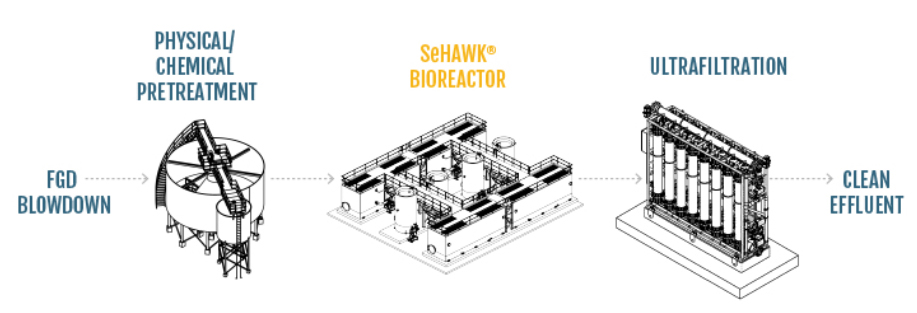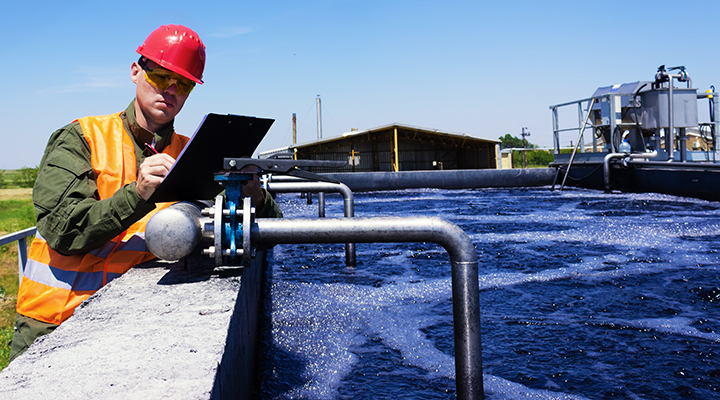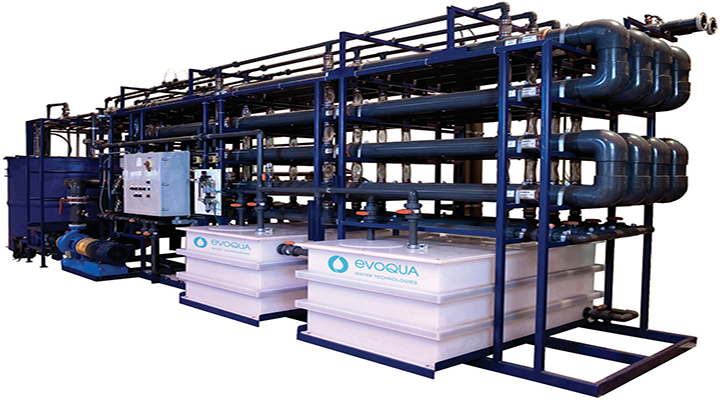Fossil-fuel power plants emit exhaust that includes sulfur dioxide —among other substances considered harmful to the natural environment—that must be treated before being released. State, federal and even global regulations have required a reduction in the level of pollutants found in these flue gases.
One of the most commonly used flue gas desulfurization (FGD) technologies for controlling pollutants from power plant gas emissions is a wet scrubber system. In this process, many contaminants end up in the circulating water in the scrubber. To maintain appropriate operating conditions, a constant purge stream is discharged from the scrubber system. The purge stream contains contaminants from coal, limestone, and make-up water. It is acidic and supersaturated with gypsum, with high concentrations of total dissolved solids (TDS), total suspended solids (TSS), heavy metals, chlorides and, occasionally, dissolved organic compounds. Prior to discharge the wastewater requires treatment for the reduction of key contaminants, including suspended solids, selenium, arsenic, mercury, total nitrates, and selected heavy metals to very low concentrations.
 Evoqua can help your plant meet regulations related to flue gas desulfurization wastewater treatment.
Evoqua can help your plant meet regulations related to flue gas desulfurization wastewater treatment.
The scrubber purge stream—or flue gas desulfurization (FGD) wastewater—is most often treated in a dedicated wastewater facility rather than a plant's existing wastewater treatment system, because the power plant's existing wastewater treatment facility may not have adequate capacity, be able to receive a high chloride wastewater stream, or be able to treat to the very strict FGD wastewater discharge limits. Wastewater composition can vary significantly from plant to plant due to coal selection, scrubber chloride concentrations, efficiency of the fly ash removal, the type of gypsum dewatering system, and the type of FGD process used. Evoqua provides customized solutions for each application. In most cases, our flue gas desulfurization wastewater treatment solution is comprised of two primary steps.
Step 1 - Bulk Contaminant Removal Process
FGD wastewater is collected in an equalization tank, then pumped through reaction tanks where suspended solids are removed by adding the following:
-
Alkali to allow gypsum to de-saturate
-
Organo-sulfide to further precipitate heavy metals
-
Iron salts to drive co-precipitation, enhancing clarifier performance
-
Polymer to aid in flocculation and solids settling and hydrochloric acid to neutralize the effluent pH, mitigating scaling in downstream equipment
-
Clarifier sludge is sent to a holding tank prior to being dewatered in filter presses on a batch basis. The dewatered solids, or "filter cake" is discharged from filter presses and disposed of in non-hazardous lined landfills, either on- or off-site.
- Gravity filtration polishes the treated effluent to enhance TSS and metals reduction prior to discharge. The treated effluent flows to the permitted discharge point.

Step 2 - Advanced Treatment and Final Polishing
To meet the regulatory limits for Selenium, Nitrates, and Mercury further treatment is required. The EPA has recognized Low Residence Time Biological Treatment (LRBT) with Ultrafiltration Polishing as the Best Available Technology (BAT) for this purpose. Frontier Water System’s modular bioreactors are the industry standard to achieve optimal treatment results.
Evoqua’s partnership with Frontier Water Systems provides utilities with a combination of best in class technologies to meet the most challenging water treatment standards reliably, consistently and economically.
In most cases, due to the stringent effluent limitation guidelines discharge limits, additional polishing of the treated wastewater will be required.
Frontier Water Systems provides biological advanced treatment solutions where appropriate. This low retention time biological system is known as SeHawk®. The EPA has designated the combination of physical-chemical treatment and low rate biological treatment as the Best Available Treatment (BAT) technology.




